Related Research Articles

A sugar beet is a plant whose root contains a high concentration of sucrose and which is grown commercially for sugar production. In plant breeding, it is known as the Altissima cultivar group of the common beet. Together with other beet cultivars, such as beetroot and chard, it belongs to the subspecies Beta vulgaris subsp. vulgaris but classified as var. saccharifera . Its closest wild relative is the sea beet.

Molasses is a viscous substance, principally obtained from the refining of sugarcane or sugar beet juice into sugar. Molasses varies in the amount of sugar, the method of extraction and the age of the plant. Sugarcane molasses is usually used to sweeten and flavour foods. Molasses is a major constituent of fine commercial brown sugar. It is also one of the main ingredients used to distill rum.
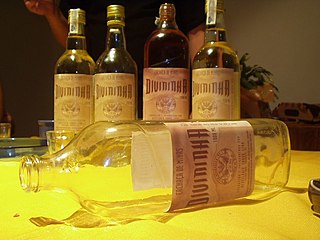
Cachaça is a distilled spirit made from fermented sugarcane juice. Also known as pinga, caninha, and other names, it is the most popular spirit among distilled alcoholic beverages in Brazil. Outside Brazil, cachaça is used almost exclusively as an ingredient in tropical drinks, with the caipirinha being the most famous cocktail. In Brazil, caipirinha is often paired with the dish feijoada.

Aguardente (Portuguese), or aguardiente (Spanish), is a type of distilled alcoholic spirit that contains between 29% and 60% alcohol by volume (ABV). It is a somewhat generic term that can refer to liquors made from various foods. It originates from and is typically consumed on the Iberian Peninsula and in Iberian America.

Kilju is the Finnish word for home made alcoholic beverage typically made of sugar, yeast, and water.

A sugar refinery is a refinery which processes raw sugar from cane or sugar extracted from beets into white refined sugar.

Golden syrup or light treacle is a thick, amber-coloured form of inverted sugar syrup made by the process of refining sugar cane or sugar beet juice into sugar. It is used in a variety of baking recipes and desserts. It has an appearance and consistency similar to honey, and is often used as a substitute where honey is unavailable.

Arrack is a distilled alcoholic drink typically produced in India, Sri Lanka and Southeast Asia, made from the fermented sap of coconut flowers or sugarcane, and also with grain or fruit depending upon the country of origin. It is sometimes spelled arak, or simply referred to as 'rack or 'rak. It is not to be confused with the anise-flavored distilled spirit called arak or araq. In many parts of India arrack is colloquially known as "desi daru".
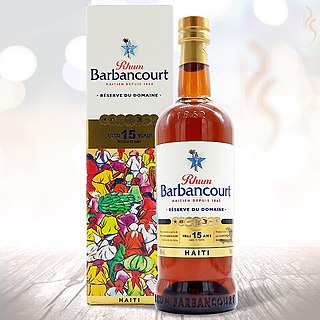
Rhum Barbancourt is rum produced from pure sugar cane juice and bottled in Haiti by Société du Rhum Barbancourt. The distillery is one of Haiti's oldest institutions, and its rum is the country's most famous export, widely regarded as among the finest rums in the world for over 150 years.
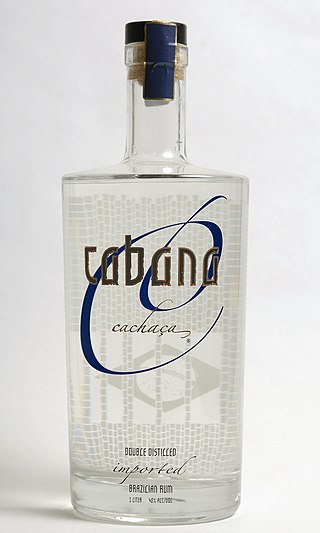
Cabana Cachaça is a brand of Brazilian-made cachaça that is fermented and distilled directly from freshly pressed sugarcane.

Sugarcane or sugar cane is a species of tall, perennial grass that is used for sugar production. The plants are 2–6 m (6–20 ft) tall with stout, jointed, fibrous stalks that are rich in sucrose, which accumulates in the stalk internodes. Sugarcanes belong to the grass family, Poaceae, an economically important flowering plant family that includes maize, wheat, rice, and sorghum, and many forage crops. It is native to the warm temperate and tropical regions of India, Southeast Asia, and New Guinea. Grown in tropical and subtropical regions, sugarcane is the world's largest crop by production quantity, totaling 1.9 billion tonnes in 2020, with Brazil accounting for 40% of the world total. Sugarcane accounts for 79% of sugar produced globally. About 70% of the sugar produced comes from Saccharum officinarum and its hybrids. All sugarcane species can interbreed, and the major commercial cultivars are complex hybrids.
Travellers Liquors Limited is a distiller based in Belize. The company produces a variety of different liquors, specializing in aged rum.

Rum is a liquor made by fermenting and then distilling sugarcane molasses or sugarcane juice. The distillate, a clear liquid, is often aged in barrels of oak. While strongly associated with the Caribbean to this day due to its Barbadian origin, rum is nowadays produced in nearly every major sugar-producing region of the world, such as the Philippines, where Tanduay Distillers, the largest producer of rum worldwide, has its headquarters.

Palm syrup is an edible sweet syrup produced from the sap of a number of palms. It is produced in the Canary Islands and coastal regions of South America.

10 Cane was a premium Trinidadian light rum brand owned by LVMH. Moët Hennessy introduced 10 Cane in 2005. The product was discontinued in 2015. 10 Cane rum was named after the tradition of hand-harvesting and bundling sugarcane stalks in groups of ten.
This is an alphabetic list of moonshine produced in various countries. The term bathtub gin refers to any style of homemade spirit made in amateur conditions of historical reason. Some distilled drinks on the list below are flavored, and some also national liquors.

Rhum agricole is the French term for sugarcane juice rum, a style of rum originally distilled in the French Caribbean islands from freshly squeezed sugarcane juice rather than molasses. Rhum is the term that typically distinguishes it in French-speaking locales from the rum made with molasses in other parts of the West Indies.
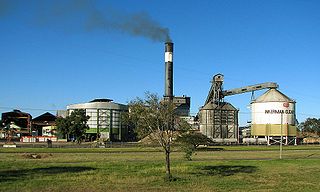
A sugar cane mill is a factory that processes sugar cane to produce raw sugar or plantation white sugar. Some sugar mills are situated next to a back-end refinery, that turns raw sugar into (refined) white sugar.
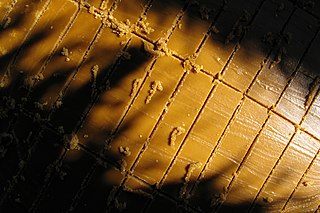
Non-centrifugal cane sugar (NCS) is the technical name given to traditional raw sugar obtained by evaporating water from sugarcane juice. NCS is internationally recognized as a discrete and unique product by the FAO since 1964 and by the World Customs Organization (WCO) since 2007. WCO defines NCS as "cane sugar obtained without centrifugation". It also states that "the product contains only natural anhedral micro-crystals, of irregular shape, not visible to the naked eye, which are surrounded by molasses' residues and other constituents of sugar cane". NCS is produced in most sugarcane-growing regions of the world, being known by many different names such as panela, jaggery, or gur. Some varieties of muscovado are non-centrifugal.
References
- ↑ Ruthström, Bo (2001). "Tafia, Ratafia and Rum — Liquor Words of Dizzy Origin". Indogermanische Forschungen. 106 (1): 262–275. doi:10.1515/if-2001-0117. ISSN 1613-0405. S2CID 201278038.
- 1 2 Williams, Elizabeth M. (2016). Lift Your Spirits: A Celebratory History of Cocktail Culture in New Orleans. Baton Rouge, Louisiana: LSU Press. pp. 13–14. ISBN 978-0-8071-6327-6. OCLC 1111982084 – via Google Books.
- ↑ Bossart, Céline (January 25, 2021). "Get Ready to Fall in Love with Haiti's One-of-a-Kind Rum". Liquor.com. Retrieved July 26, 2022.